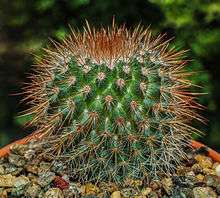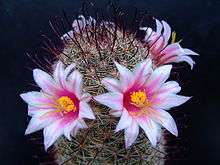Mammillaria
| Mammillaria | |
|---|---|
 | |
| Mammillaria spinosissima | |
| Scientific classification | |
| Kingdom: | Plantae |
| (unranked): | Angiosperms |
| (unranked): | Eudicots |
| (unranked): | Core eudicots |
| Order: | Caryophyllales |
| Family: | Cactaceae |
| Subfamily: | Cactoideae |
| Tribe: | Cacteae |
| Subtribe: | Cactinae |
| Genus: | Mammillaria Haw. |
| Species | |
|
About 170 species: see text | |
| Synonyms | |
| |
The genus Mammillaria is one of the largest in the cactus family (Cactaceae), with currently 200 known species and varieties recognized.[1] Most of the mammillarias are native to Mexico, but some come from the southwest United States, the Caribbean, Colombia, Venezuela, Guatemala and Honduras.[2] The common name "pincushion cactus" refers to this and the closely related genus Escobaria.
The first species was described by Carl Linnaeus as Cactus mammillaris in 1753, deriving its name from Latin mammilla, "nipple", referring to the tubercles that are among the distinctive features of the genus. In 1812, the cactus specialist Adrian Haworth described the genus Mammillaria to contain this and related species. Numerous species are commonly known as globe cactus, nipple cactus, fishhook cactus or pincushion cactus though such terms may also be used for related taxa, particularly Escobaria.
Description

The distinctive feature of the genus is the possession of an areole split into two clearly separated parts, one occurring at the apex of the tubercle, the other at its base. The apex part is spine bearing, and the base part is always spineless, but usually bears some bristles or wool. The base part of the areole bears the flowers and fruits, and is a branching point. The apex part of the areole does not carry flowers, but in certain conditions can function as a branching point as well.
The plants are usually small, globose to elongated, the stems from 1 cm to 20 cm in diameter and from 1 cm to 40 cm tall, clearly tuberculate, solitary to clumping forming mounds of up to 100 heads and with radial symmetry. Tubercles can be conical, cylindrical, pyramidal or round. The roots are fibrous, fleshy or tuberous. The flowers are funnel-shaped and range from 7 mm to 40 mm and more in length and in diameter, from white and greenish to yellow, pink and red in colour, often with a darker mid-stripe; the reddish hues are due to betalain pigments as usual for Caryophyllales. The fruit is berry-like, club-shaped or elongated, usually red but sometimes white, magenta, yellow or green. Some species have the fruit embedded into the plant body. The seeds are black or brown, from 1 to 3 mm in size.
Cultivation
Mammillarias have extremely variable spination from species to species, and attractive flowers, making them attractive for cactus hobbyists. Most mammillarias are considered easy to cultivate,[2] though some species are among the hardest cacti to grow. Several taxa are threatened with extinction at least in the wild, due to habitat destruction and especially overcollecting for the pot plant trade. Cactus fanciers can assist conservation of these rare plants by choosing nursery-bred specimens (wild-collected ones are illegal to possess for the rarest species). Several mammillarias are relatively easy (for cacti) to grow from seeds. One such species, popular and widely available from nursery stock but endangered in the wild, is Mammillaria zeilmanniana.
Systematics

The large and diverse genus Mammillaria has seen multiple attempts to subdivide the species in it into smaller groups within the genus or attempts to split it into multiple genera for better understanding of the plants' relationship. Early classifications were performed by Pfeiffer (1837), Salm-Dick (1845) and Engelmann (1856). The genus Mammillaria included members of some modern genera like Coryphantha and Ariocarpus at that time. Classifications by Schumann (1898), Britton and Rose (1923), Berger (1929) Buxbaum (1951–56) and Moran (1953) followed, splitting the genus in parts and combining it back together again.
Later classification was performed by the cactus specialists Hunt, Reppenhagen and Luthy, with much work focusing on researching the meanings and value of the original plant descriptions, synchronizing them with modern taxonomic requirements and studying the morphology of plants and seeds, as well as ecological aspects of the genus. These works helped to expand the understanding of Mammillaria taxa.
Currently the classification of Mammillaria is in a state where few newly discovered species are likely, though some new species may yet be found when the chaos of names created earlier by commercial plant collectors is sorted out. Many names that were introduced for plants barely differentiated by a shade of flower colour or variation in spination were eliminated in attempt to make the use of names consistent with the rest of the botanical world. The number of taxa, which at one time numbered above 500, is now below 200. Some genera (Dolichothele, Mammillopsis, Krainzia and others) have been merged back into Mammillaria, and others like Coryphantha, Escobaria and Mammilloydia were confirmed as separate.
Intense studies of DNA of the genus are being conducted, with preliminary results published for over a hundred taxa, and this promising approach might soon end the arguments. Based on DNA research results, the genus does not seem to be monophyletic and is likely to be split into two large genera, one of them possibly including certain species of other closely related genera like Coryphantha, Ortegocactus and Neolloydia.
Selected species
As noted above, some might not belong into this genus.
|
Mammillaria bombycina
Mammillaria plumosa
Mammillaria vetula
 Mammillaria sheldonii
Mammillaria tetrancistra
|
References
- ↑ "Notes for the Genus: Mammillaria".
- 1 2 Anderson, Miles (2008). The Complete Illustrated Guide to Growing Cacti & Succulents. London: Lorenz Books. p. 84. ISBN 9780754818427.
Further reading
- Anderson, Edward F. (1991): The Cactus Family
- Butterworth, Charles A. & Wallace, Robert S. (2004): Phylogenetic studies of Mammillaria (Cactaceae) - insights from chloroplast sequence variation and hypothesis testing using the parametric bootstrap. Am. J. Bot. 91(7): 1086-1098. PDF fulltext Supplementary data
External links
| Wikimedia Commons has media related to Mammillaria. |
- cactiguide.com is the main source for the species list, and in turn sourced from several books which are listed on that site.
- mammillarias.net is the main up-to-date internet resource, with complete species and varieties description, distribution maps and a large selection of photographs of all Mammillaria species both in nature and cultivated.
- SucculentCity Mammillaria Page: Cultivation Data and Photographs